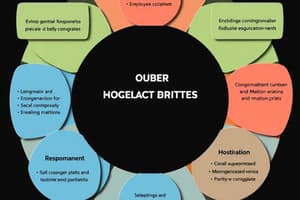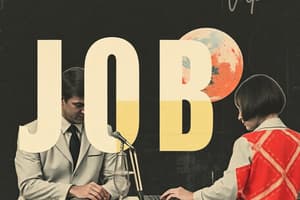Podcast
Questions and Answers
What is skill variety?
What is skill variety?
- The periodic shifting of an employee from one task to another
- The degree to which a job provides autonomy
- A system in which workers participate in decision making
- The degree to which a job requires a variety of different activities (correct)
What does the job characteristics model (JCM) propose?
What does the job characteristics model (JCM) propose?
It proposes that any job can be described in terms of five core job dimensions: skill variety, task identity, task significance, autonomy, and feedback.
What is job design?
What is job design?
The way the elements in a job are organized.
What is task identity?
What is task identity?
What is task significance?
What is task significance?
What does autonomy in a job refer to?
What does autonomy in a job refer to?
What is feedback in the context of a job?
What is feedback in the context of a job?
What is job rotation?
What is job rotation?
What does motivating potential score (MPS) indicate?
What does motivating potential score (MPS) indicate?
What is job enrichment?
What is job enrichment?
What is flextime?
What is flextime?
What is job sharing?
What is job sharing?
What is telecommuting?
What is telecommuting?
What is employee involvement?
What is employee involvement?
What is representative participation?
What is representative participation?
What is participative management?
What is participative management?
What is a variable-pay program?
What is a variable-pay program?
What is a piece-rate pay plan?
What is a piece-rate pay plan?
What is a merit-based pay plan?
What is a merit-based pay plan?
What is a bonus?
What is a bonus?
What is skill-based pay?
What is skill-based pay?
What is a profit-sharing plan?
What is a profit-sharing plan?
What is an employee stock ownership plan (ESOP)?
What is an employee stock ownership plan (ESOP)?
Flashcards are hidden until you start studying
Study Notes
Job Characteristics and Design
- Skill Variety: Refers to the range of different tasks and activities required in a job, enhancing employee engagement.
- Job Characteristics Model (JCM): Describes jobs via five core dimensions: skill variety, task identity, task significance, autonomy, and feedback, providing a framework for job design.
- Job Design: Involves organizing job elements to improve satisfaction and productivity.
Task Dimensions
- Task Identity: The extent to which a job allows completion of a recognizable and whole piece of work, leading to higher employee satisfaction (e.g., a cabinetmaker vs. a lathe operator).
- Task Significance: Measures the impact of a job on others' lives, with higher significance in roles like nursing compared to janitorial work.
- Autonomy: Indicates the freedom and independence in job execution; higher autonomy allows workers to schedule and determine procedures without supervision.
- Feedback: The clarity and directness of performance information from work activities; jobs with high feedback create better awareness of performance.
Job Management Techniques
- Job Rotation: Involves periodically shifting employees among different tasks to increase engagement and reduce monotony.
- Motivating Potential Score (MPS): An index predicting the motivational potential of a job based on the combination of its characteristics.
- Job Enrichment: Focuses on vertical job expansion, enhancing control over planning, execution, and evaluation of work.
Flexible Work Arrangements
- Flextime: Offers employees flexible working hours, promoting work-life balance.
- Job Sharing: Allows two or more employees to share the responsibilities of a single full-time position.
- Telecommuting: Enables employees to work from home at least two days a week, fostering a flexible workplace environment.
Employee Involvement and Participation
- Employee Involvement: A process encouraging employee input to boost commitment to organizational success.
- Representative Participation: Workers engage in decision-making through a selected group of representatives.
- Participative Management: Subordinates have a significant share in decision-making alongside their immediate supervisors.
Compensation Strategies
- Variable-Pay Program: Links part of employee compensation to individual or organizational performance metrics.
- Piece-Rate Pay Plan: Employees receive a fixed payment for each unit produced, incentivizing productivity.
- Merit-Based Pay Plan: Compensation based on performance appraisals.
- Bonus: Rewards employees based on recent performance rather than historical achievements.
- Skill-Based Pay: Earnings are determined by the number of skills and roles an employee is qualified for, promoting skill development.
- Profit-Sharing Plan: Distributes compensation based on a company’s profitability under a defined formula.
- Employee Stock Ownership Plan (ESOP): Offers employees stock options, often at reduced prices, as part of their benefits package.
Studying That Suits You
Use AI to generate personalized quizzes and flashcards to suit your learning preferences.




